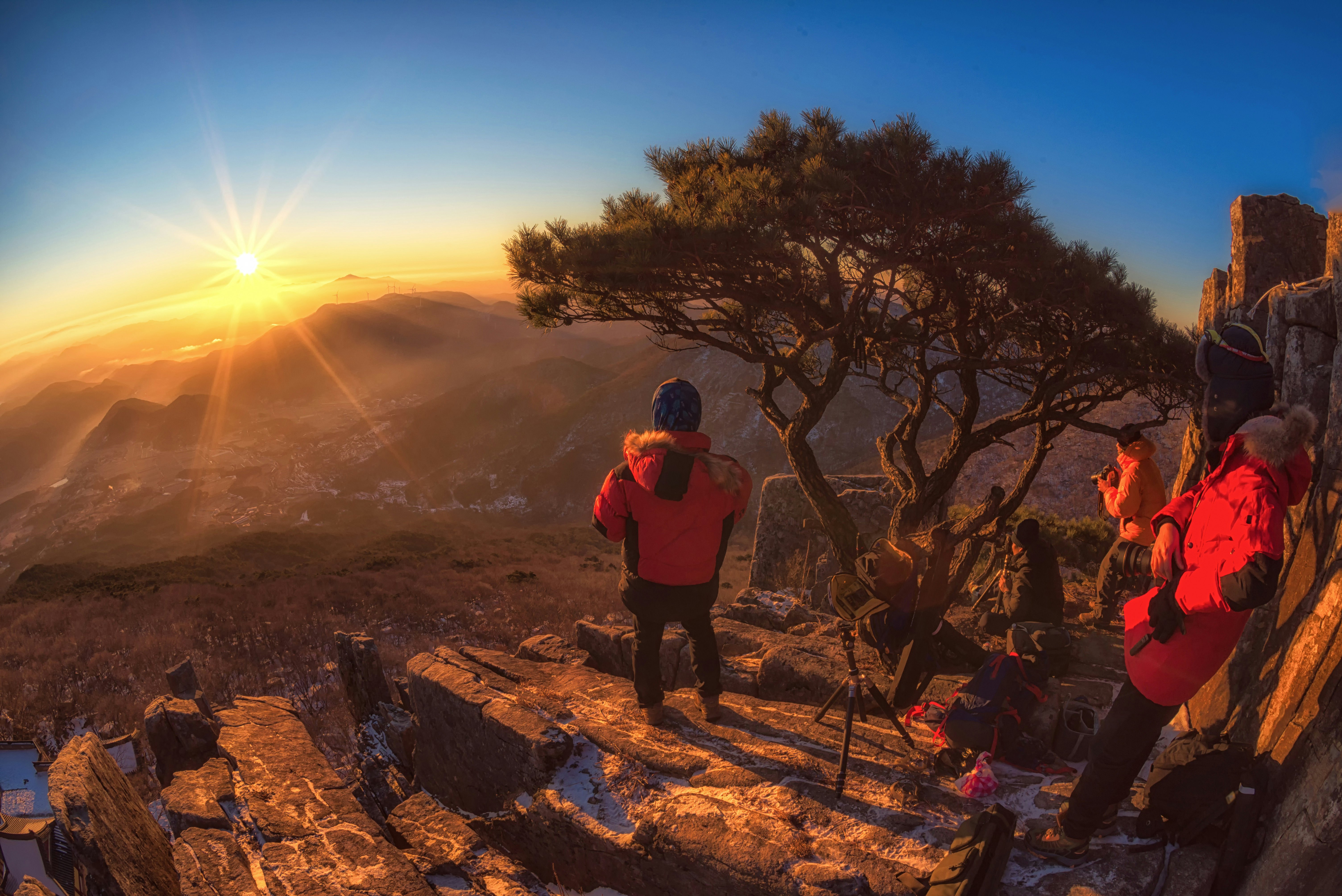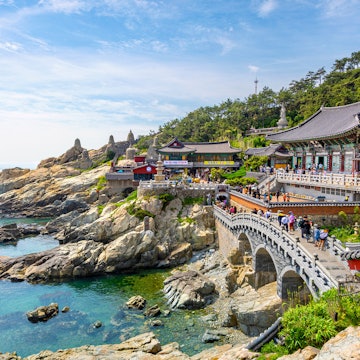

Admire the golden gingko trees in South Korea's incredible national parks © d3sign / Getty Images
Known for the sparkle and flash of K-pop, the stylish flair of K-drama and the flawless veneer of K-beauty – all with megacity Seoul looming large – South Korea might not strike the unsuspecting visitor as all that "nature-y" of a destination.
But this small nation of 100,000 sq km (about the size of the US state of Indiana) is made up of a surprising number of national parks, 22 to be exact. That’s 6.7% of South Korea’s total land mass. By comparison, the United States’s 63 national parks comprise 3.6% of its land.
South Korea’s first national park, a mountainous territory, came under formal protection in 1967. In the years since, 17 other rocky regions have risen to the same status. But the country’s national park system isn’t limited to strictly hilly terrain: it also includes three marine and coastal national parks and one historical national park, all designated as such to preserve the natural environment and historical culture of South Korea.
Whether you’re looking for a day trip of easy strolling, or a multi-day excursion through some of the peninsula’s most challenging mountain passes or even a boat ride on the ocean, you’ll find it within South Korea’s national park system. You’ll have to pay a nominal entrance fee (most charge around ₩2000 to ₩4000 for upkeep, about US$1.60 to US$3.20, though some are free), and don’t forget to pack up your trash to take out with you (public garbage bins are not a fixture).

Jirisan
Best national park for hiking enthusiasts
As the country’s oldest and biggest national park (terrestrially at least), Jirisan holds a special place in many Koreans’ hearts. At 472 sq km (182 sq miles), Jirisan is so expansive that it occupies three of the nation’s nine provinces: Gyeongsangnamdo, Jeollanamdo and Jeollabukdo. The peaks are sure to exhilarate thrill-seekers – Jirisan contains the tallest mainland mountain, Cheonwangbong – while the valleys will soothe and calm those less vertically inclined. Options for trekking abound, with 18 different trails to choose from. Most memorable is the Jongju Course, a three-day, two night hike that traverses 13 peaks and 25.5 km (15.8 miles) and is outfitted along the way with overnight shelters that are bookable in advance.
Jirisan is well known for its diversity of wildlife and plants. Keep an eye out for elk among the cherry, millennium pine and Korean winter hazel trees. If you’re lucky, you might also spot an endangered Asiatic black bear.
Bukhansan
Best national park for travelers staying in Seoul
A short bus ride from Gupabal subway station (Line 3), Bukhansan is the capital city’s nearest national park, earning it the moniker “the lungs of Seoul.” It’s also South Korea’s most popular national park, with more than five million visitors annually. For Seoulites, Bukhansan presents a chance to escape their grueling nine-to-five lives as company workers and, for a short time, be creatures in the wild, capering along the park’s streams, gorges and peaks (the highest being Baegundae), as one of the more than 1300 different species that call this site home.
But so much public interest in Bukhansan has taken its toll on its ecosystem, so tourists might consider combining their visit with a cleanup day or park maintenance experience. Pay close attention to any access restrictions underway. Other noteworthy attractions at Bukhansan include its namesake fortress Bukhansanseong, along with old Buddhist temples and monastic cells.

Dadohaehaesang
Best national park for island hoppers
One of South Korea’s three marine and coastal national parks, Dadohaehaesang is also its largest park overall, covering nearly 2000 sq km (772 sq miles) of water and 335 sq km (129 sq miles) of land. Among Dadohaehaesang’s seven coastal areas in the Yellow Sea are Heuksando, a smattering of 100 relatively unvisited – and a few totally uninhabited – islands; Jindo, the isle of the quintessential Korean dog breed; and Cheongsando, the legendary land of Taoist fortunes and eternal energies. Get from island to island aboard passenger ships, which run year round.
In addition to spectacular rock formations, Dadohaehaesang also features lush evergreen forests and rare finless porpoises, making for a mystical, almost mythical atmosphere.
Seoraksan
Best national park for families and children
Cherished by hiking experts and novices alike, Seoraksan National Park has a trail for everyone in your visiting walking group – and even a cable car if that’s more your speed. Set in the northeasternmost stretches of the country, Seoraksan is a prime spot to see the sun rise over the Land of Morning Calm and to catch the colors changing in fall.
Particular points of interest include Biryong, Daeseung and Yongso waterfalls (all soft, slight climbs with barely any incline); the six-peaked rock formation Ulsan Bawi (much more severe and strenuous) and Daecheongbong (the highest summit at Seoraksan).

Hallasan
Best national park for winter visitors
For travelers coming to see Korea in all its winter splendor, no place is more magical than Hallasan, the shield volcano at the center of Jeju Island. As the tallest mountain in all of South Korea, Hallasan cuts an imposing figure across the sky, especially striking in the snowy season when the slopes glitter to crystalline effect and the endangered Korean fir trees are blanketed in white. Hallasan National Park isn’t confined to just the mountain itself. Surrounding the main peak are hundreds of parasitic cones, the legacy of millennia of eruptions that lasted into the 11th century.
At the top of Hallasan is the crater lake Baengnokdam. It’s usually reached by Seongpanak, accessible in three-hour increments by reservation on the Hallasan National Park website.
Gyeongju
Best national park for history buffs
The country’s only historical national park is Gyeongju National Park, spanning eight separate districts in southeastern South Korea. Ornamented with relics dating back to the Shilla dynasty (57 BCE to 935 CE) when the city was the ancient capital of Korea, Gyeongju’s landscape is an education unto itself. Encircling the downtown in clusters, the park features a wide variety of regional hallmarks, ranging from the ecological (more than two dozen endangered species) to the spiritual (Buddhist pagodas, statues and temples, including the famed cave temple Seokguram).
For an outdoor museum adventure, follow one of Namsan, Tohamsan or Danseoksan districts’ eight history and culture trails. Those with a penchant for religious studies might try out Samneung, Bonghwagol or Sinseonsa, all known for their rock-carved Buddhas, sitting meditatively and overlooking the expanse. Sinseonsa also covers the site where ancient Hwarang warriors, the elite fighters of the Silla Kingdom, underwent their training. Most of these are gentle walks that take anywhere from 90 minutes to four hours, but some are visitable by reservation only to protect the environment.
















